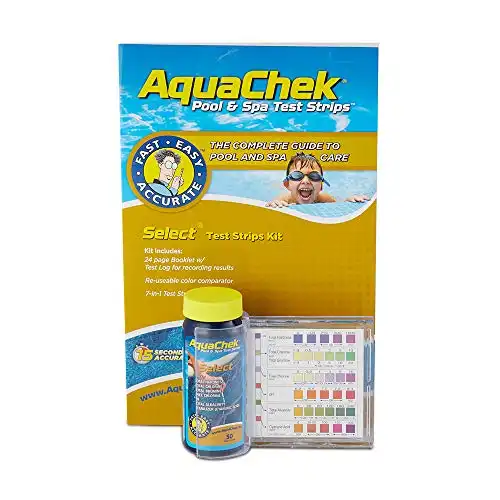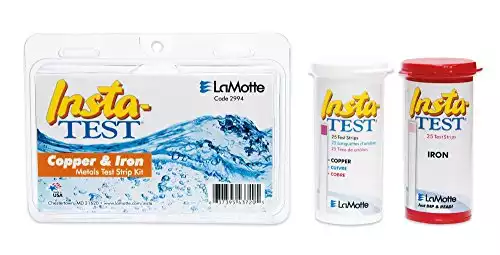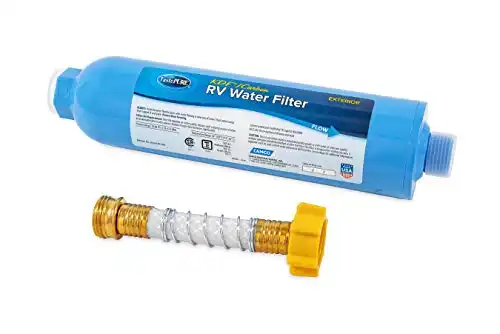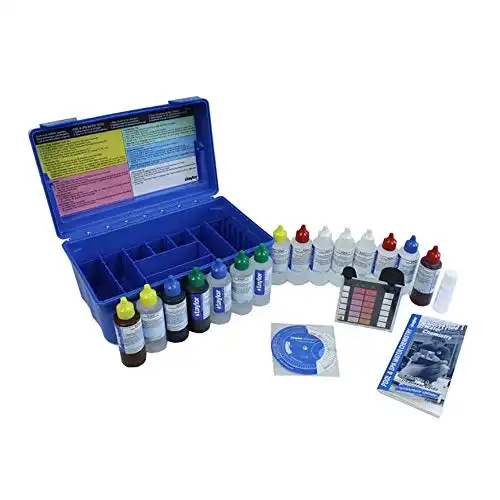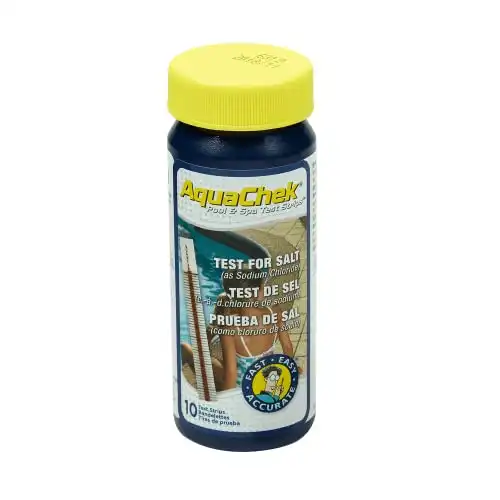Is your hot tub water looking a little … off? Maybe a sort of cloudy, or a slightly greenish? Whatever the case, it’s just not the crystal clear water you want to soak in.
Sure hope you have some spa test strips handy, because that’s going to be your first step in diagnosing a problem
The majority of problems with hot tub water come about because it’s not balanced. Before you can add the right chemicals in the right amounts, you have to do some hot tub water testing to determine know what’s going on.
Hot Tub Water Testing is the First Step
Out of all the hot tub maintenance tasks you’ll perform over the life of your hot tub, spa water testing is the one thing you’ll do more often than anything else. At least, it should be.
The only way you’re going to know whether the water contains any contaminants or what the chemical levels are is to test the water. And that means hot tub test strips are your best buddies.
Accurate Spa Water Testing Tips
It’s not as difficult as you may think it is, especially when you have so many testing options available to you:
- Use spa test strips for quick and easy results.
- Use a liquid test kit for more comprehensive results
- Take a water sample to your local spa dealer or pool store for the most thorough and accurate results
No matter what testing method you use, the key is to make sure you correctly take the water sample.
How to Collect a Hot Tub Water Sample
What matters just as much as how you collect the sample is that you get it from the middle of your hot tub.
- Use a clean cup or bottle (with a cap if you’re taking it to a store).
- Hold it upside down so the opening faces the hot tub floor.
- Insert the vessel into the water elbow-deep, and then turn it right side up to collect the water.
Important: Do not take the sample near any of the jets. Try to get as close to the middle of the hot tub as possible.
How to Use Spa Test Strips
It may seem counterintuitive, but test strips can sometimes actually be more accurate than liquid test kits because it can be difficult to match up the colors with the chemical drops. They’re also much easier to use.
In addition, hot tub test strips are usually less expensive than liquid testing kits, but you’ll probably end up going through them more quickly, so cost may not really be a factor in which one you choose.
To use spa test strips:
- Collect a water sample.
- Dip a strip into the water, and quickly pull it out; it doesn’t need to soak.
- Hold it still for about 15 seconds. Don’t shake it!
- Compare the strip to the guide on the package, matching up the colors on both.
- Balance the water accordingly.
You’ll most often use regular hot tub test strips that check for things like pH, alkalinity, and chlorine. But if you also need to test for other components such as iron, copper, and salt, you can find specialty strips.
Tests for 7 important chemistries in seconds: Total Hardness, Total Chlorine, Total Bromine, Free Chlorine, pH, Total Alkalinity, and Cyanuric Acid.
How to Use a Liquid Test Kit
If you go with this option, make sure it includes phenol red and orthotolidine (OTO) to test pH and chlorine, respectively.
- Collect a water sample; your test kits should come with a collector.
- Add the recommended number of drops of phenol red to the water on the pH side.
- Add the recommended number of drops of OTO to the water on the chlorine side.
- Hold the collector up in front of a white background, and compare the colors of the water to the color scales on the collector. High pH is indicated by darker shades of red water, and high chlorine is indicated by darker shades of yellow.
You’re shooting for a pH level between 7.4 and 7.6, with 7.5 being ideal.
Important: If the levels are low, the colors will be faint and difficult to see. For better accuracy, be sure to hold the collector up against a white background. Just a sheet of paper will do.
Professional Water Testing
To take a water sample to a dealership for testing, collect the sample the same way you would if you were going to perform spa water testing at home. They may take walk-ins, but call ahead to make sure they’ll be able to help you.
When to Test Hot Tub Water
To make sure the water stays sanitized and that alkalinity and pH are always in balance, perform hot tub water testing at least once a week. If your spa gets a lot of use, it’s been rained on, test it more often. And of course, test it whenever you add chemicals.
We highly recommend you take a sample to a store once a month for a professional test, as well as when you open and close your hot tub.
If your hot tub isn’t properly balanced, you can follow our guides about balancing pH in a hot tub and how to lower alkalinity in a hot tub.
Keep Contaminants at Bay
If your water comes from a well, you may have higher levels of iron and copper in your hot tub. If you use city water, it may be hard, which means it contains higher levels of calcium and magnesium.
All of those factors can cause problems in your spa, including chemicals imbalances, hot tub stains, and other surface damage, meaning you’ll need to test the water more often.
Prevention costs a lot less than repairs.
Cut the confusion with our easy-to-use video course. Save $1,000's on hot tub care and keep your water clean and clear for good!
Learn MoreHow to Test for Copper
If you have greenish or black stains on the shell or cloudy spa water, you may have a copper problem. It builds up in two ways.
First, the water you fill your hot tub with may contain copper. As the water evaporates from your spa, copper is left behind behind. As this continues, copper levels rise, leading to cloudy water and stains.
Because the spa has lost water to evaporation, you’ll add more, which means you add more copper, and then more water evaporates, and that leads to … yup, more copper in your hot tub.
Second, copper elements in your hot tub filter or plumbing may corrode due to a low pH level, and that corrosion will end up in the water. The longer you let it go, the worse it will get.
How to Test Your Hot Tub Water for Copper
Most spa test strips don’t test for metals. In addition to the ones you get for pH, chlorine, and other standard factors, you’ll need a set made especially for metal testing.
How Often to Test for Copper
It’s essential to test the pH level weekly as that can lead to a copper issue. But as for copper itself, you should only have to test the water once a month.
How to Fix High Copper Levels
After testing your hot tub water, if you do find it contains a high level of copper, you have a couple of options to remedy it.
Metal Sequestrant
Usually a liquid you add to your hot tub water, a sequestrant binds with metals—specifically, iron, copper, and nickel—in the water to prevent them from oxidizing, or rusting, which is what causes stains. Once the metal particles are bound, they can be removed by the hot tub filter.
Be aware that a sequestrant does not remove metals from the water. And sequestrant breaks down over time, so you may need to add it on a regular basis if you have high metal levels in your water.
Learn what chemicals and minerals are present in the water where you live, and then follow the manufacturer’s instructions to ensure you use the sequestrant properly.
Hose Filter
If your water source has high metal levels, a hose filter can keep at least some of them out when you fill your hot tub.
Fill your pool or hot tub with this hose filter that'll filter your water so you can have a fresh start with water chemistry.
Test for Iron
Another good reason to test the pH level weekly is that a low level can also cause iron levels to rise, if there’s iron present in the source water.
Again, if your water comes from a well, it may have high metal levels. The process of iron being deposited in the spa is the same as for copper. Only in this case, the water will be brown or rust-colored. Ew.
How to Test Your Hot Tub Water for Iron
Usually, the same strips or kit that test for copper will also test for iron. It just makes sense as both are metal elements.
The only difference will be that once you’ve filled the test tube with a sample of your hot tub water, you’ll add a special solution made to test for iron. Then compare the water color to the color coded chart included with the kit.
How Often to Test for Iron
Once a month. But remember, test the pH level more often than that to keep iron from staining the spa shell.
How to Fix High Iron Levels
Again, because they’re both metal elements, you can fix an iron problem with the same methods used for copper: metal sequestrant, keep the pH level steady, and use a hose filter when filling your spa.
Test for Calcium
Depending on where you live, you may have to deal with hard water, which means your water source has high levels of calcium and magnesium. If you see evidence of it on your shower head, you probably also see hot tub scale from time to time.
You may also have the opposite problem—too little calcium in the water. This can cause corrosion on fixtures, surfaces, and equipment. Left too long, it can get to the point where repair isn’t possible, only expensive replacement.
The solution is to keep the calcium hardness level balanced.
How to Test Your Hot Tub Water for Calcium
For total hardness—the measurement of both calcium and magnesium salts—you’re better off using a professional grade hot tub water testing test kit rather than spa test strips.
Shoot for between 175 parts per million (ppm) and 250 ppm.
A simple but effective liquid test kit for chlorine pools and hot tubs.
How Often to Test for Calcium
Once you see scale forming, it’s too late for prevention and you’ll have to move into remedy mode. To keep that from happening, test for calcium hardness at least once a month.
But if your water source is either too soft or too hard, it’s a good idea to test more often, about once every two weeks. If your water has a serious calcium hardness issue, test once a week. You’ll be glad you did.
How to Fix High Calcium Levels
You have two options here.
Replace Some of the Water
If your water source isn’t hard, you can drain a couple of inches of water from your hot tub and replace it with softer water.
Use a Descaler
Follow the manufacturer’s instructions to ensure you use the proper amount.
Build-up of scale or calcium carbonate can potentially harm both the surface of your spa and its circulation system. The product in question effectively prevents scale by releasing potent compounds that adhere to calcium ions in your spa water, which are often the cause of such issues.
How to Fix Low Calcium Levels
Easy. Just use a calcium hardness increaser. Again, follow the manufacturer’s instructions.
This product effectively safeguards your equipment from corrosion and etching by maintaining optimal calcium hardness levels, ensuring long-lasting protection and durability.
Test for Salt
If you have a salt water hot tub, the salt you add to your hot tub is converted to chlorine. But you still need to make sure you don’t have too much or too little salt in the water. Too much can cause the chlorinator to work too hard, while too little might mean the water isn’t properly chlorinated.
This drop-in chlorinator lets you convert any hot tub or swim spa up to 2,000 gallons. Simply plug in the controller above ground and out of the water while immersing the chlorinator cell in water.
How to Test Your Hot Tub Water for Salt
To go easy on the chlorinator and keep the water sanitized, you want the salt level to be between 2,000 ppm and 3,000 ppm, with 2,500 ppm being ideal. You’ll need specialty hot tub test strips to measure salt levels. You use these the same way you use standard spa test strips.
These salt test strips are designed for measuring sodium chloride levels from 400 to 7,000 ppm. They provide accuracy comparable to liquid tests without the hassle of measuring and counting drops.
How Often to Test for Salt
You can get away with testing the salt level just once a month because it’s not as difficult to balance as other factors like pH. But if your hot tub is outside and uncovered, make sure to test after it rains, or after the spa has seen a lot of use.
How to Fix a High Salt Level
Once salt dissolves into water, it stays there, so the only way to reduce a too-high salt level is to drain a little water from the spa, then add fresh water.
How to Fix a Low Salt Level
Ooh, this one’s a toughie. Yeah, it’s gonna take a while and a lot of work. You ready? You need to … add more salt. Yup, that’s it. Fixed.
After you add salt, give it some time to dissipate, then break out the hot tub test strips again. Just add a little at a time so you don’t accidentally raise the level too much.
Professional Pool Salt crystallizes early to match the fastest dissolve rates on the market - no more waiting for hours for chlorine tablets to dissolve and produce beautiful clean water.
Always Be Testing
This is truly the easiest way to head off problems in your hot tub. Keep a supply of spa test strips on hand, and you’ll always know the status of the water you soak in, and you can address issues before they become headaches.
Happy Soaking!
The post Hot Tub Water Testing: The Complete Guide appeared first on Swim University.
